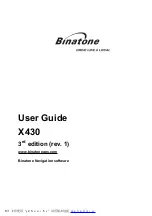
Model: MC-1-M (2U)
Doc. Ref. no. : - m05/om/101
Issue no. 14
Page 11 of 103
User’s Manual
GLONASS based satellite navigation system is maintained by Russia, a fully functional navigation
constellation in 1995. After the collapse of the Soviet Union, it fell into disrepair, leading to gaps in
coverage and only partial availability. It was recovered and fully restored in 2011. It provides an
alternative to Global Positioning System (GPS) and is the second alternative navigational system in
operation with global coverage and of comparable precision.
A fully operational GLONASS constellation consists of 24 satellites, with 21 used for transmitting signals
and three for in-orbit spares, deployed in three orbital planes. The three orbital planes' ascending nodes
are separated by 120° with each plane containing eight equally spaced satellites. The orbits are roughly
circular, with an inclination of about 64.8°, and orbit the Earth at an altitude of 19,100 km, which yields an
orbital period of approximately 11 hours, 15 minutes. The overall arrangement is such that, if the
constellation is fully populated, a minimum of 5 satellites are in view from any given point at any given
time. This guarantees for continuous and global navigation for users world-wide.
A characteristic of the GLONASS constellation is that any given satellite only passes over the exact same
spot on the Earth every eighth sidereal day (1 sidereal day = 23 hours, 56 minutes, 4.0916 seconds).
However, as each orbit plane contains eight satellites, a satellite will pass the same place every sidereal
day. For comparison, each GPS satellite passes over the same spot once every sidereal day. So
opposed to the GPS the ground-track of the GLONASS satellites do not repeat after one day. This avoids
the resonance effects which makes station keeping of GPS satellites difficult and expensive.
In GPS navigation system, all satellites operates at same frequency at 1.57542 GHz (as L1 signal) and
1.2276 GHz (as L2 signal) using CDMA technique whereas GLONASS navigation system, all satellites
operate on different frequencies using originally a 25-channel frequency FDMA technique spanning from
1602.5625 MHz to 1615.5 MHz, known as the L1 band.
As GNSS uses navigation satellite system of GPS, GLONASS and other available systems in space,
GNSS receivers can easily observer 10 to 12 satellites at a time. As more number of satellites are visible,
more accuracy in receivers output signals are achieved.
Each visible satellite broadcast two types of information in its message format i.e. Almanac and
Ephemeris. Almanac data is course orbital parameters for all visible satellites. Each visible satellite
broadcasts Almanac data for all visible satellites. This Almanac data is not very precise and is considered
valid for up to several months. Ephemeris data by comparison is very precise orbital and clock correction
for each visible satellite and is necessary for precise positioning. Each visible satellite broadcasts only its
own Ephemeris data.The ephemeris is updated every 2 hours and is usually valid for 4 hours.












































